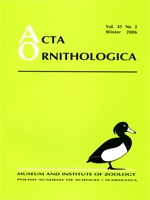The breeding ecology of the Aquatic Warbler was studied on the three largest mires in Belarus in 1998–2004. Numbers of male Aquatic Warblers on these mires range from 6370 to 11500, which is more than 50% of the species world population. In years with favorable nesting conditions breeding success on the three mires varies from 36.3% to 54.1%. In years with significant water level fluctuations and irruptions of shrew populations the breeding success decreases sharply, varying from 2.9% to 27.7%. The main reason for the mortality of eggs and nestlings was predation, probably by small insectivorous mammals. The species is well adapted to the unstable nesting conditions in fen-mires; but in years with serious flooding, high water levels throughout the nesting season, disturbances to the vegetation structure after spring fires or in years with a high density of shrews, breeding success decreases significantly.
BioOne.org will be down briefly for maintenance on 17 December 2024 between 18:00-22:00 Pacific Time US. We apologize for any inconvenience.
How to translate text using browser tools
21 January 2022
Breeding Ecology of Aquatic Warblers Acrocephalus paludicola in their Key Habitats in SW Belarus
Lyubov Vergeichik,
Alexander Kozulin
ACCESS THE FULL ARTICLE

Acta Ornithologica
Vol. 41 • No. 2
December 2006
Vol. 41 • No. 2
December 2006
Acrocephalus paludicola
Aquatic Warbler
breeding success
mires
predation
reedbeds
shrews




